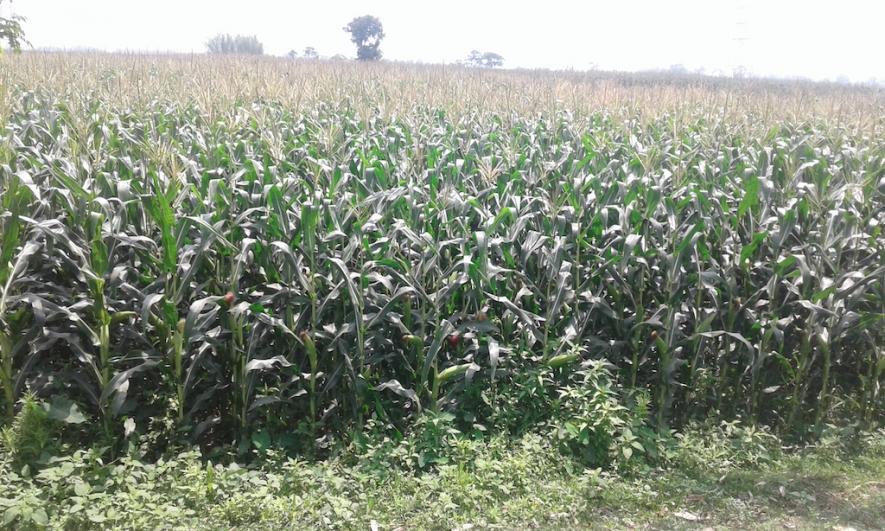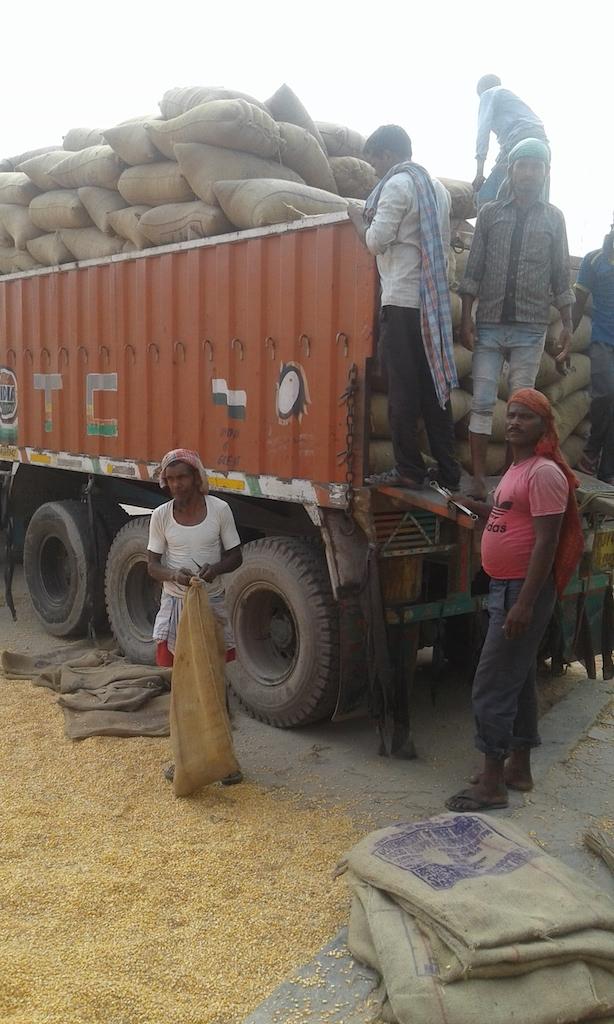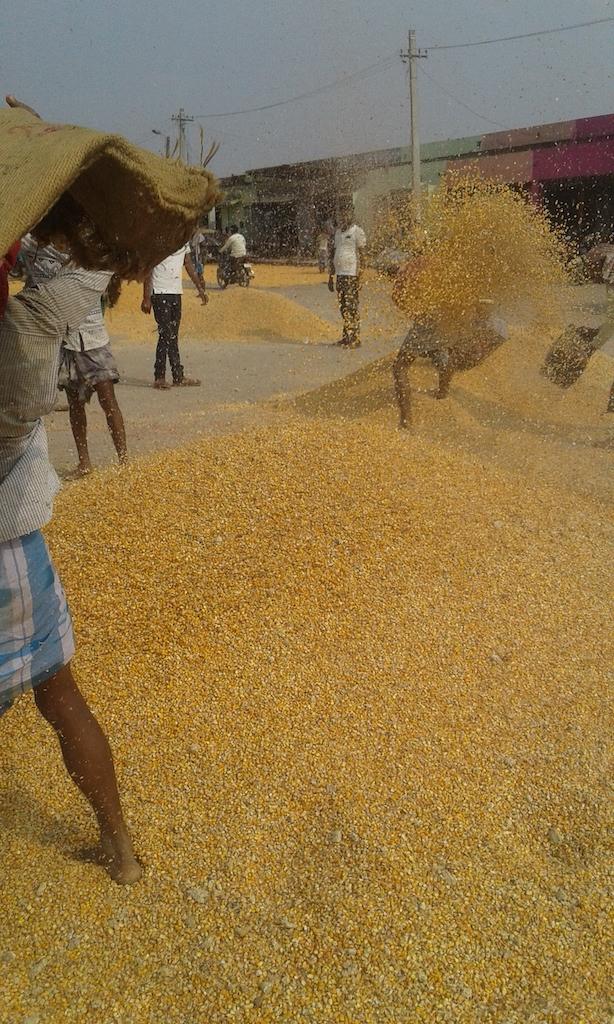Bihar’s Maize Farmers Hit Hard by the Lockdown; Price Plummets to Half of Last Year

Patna: Sambhu Kumar Yadav, a marginal farmer in Murliganj block of Madhepura district, grows maize twice a year. But, this year, he is distressed despite a good harvest. Yadav had harvested his crop nearly two weeks ago but he is not ready to sell the maize for the low prices being offered by traders; the lowest in the past decade. He blamed the ongoing lockdown for it.
Yadav also cursed the untimely, heavy rains early this month and during April for damaging his maize crop this summer. He said he refused to sell the maize as prices fell like never before due to the lockdown. “I have decided not to sell the maize that I had harvested after months of hard labour and investing money in seeds and fertilisers because I was getting half the rate that I got last year,” said Yadav.
His primary worry is that non-local traders are not able to make their way to purchase the maize directly from farmers in villages due to the lockdown, while local traders and their agents who have been visiting farmers offer low prices.
Yadav, a resident of Jamuan Tapda village under Rajni Panchayat, decided to store his maize crop in a makeshift arrangement close to his house after drying them for days under bright sunshine in the hope of a proper return next month when the selling rate is expected to go up.
He said that unlike paddy and wheat, which the state government procures directly from farmers through Primary Agriculture Credit Societies (PACS), it does not buy maize. Hence, there is no minimum support price (MSP) for maize growing farmers in Bihar. “We are deprived of MSP and traders exploit us as a result,” he added.

“I was forced to store my maize because local traders were offering between Rs 1000 to Rs 1100 per quintal, a very low price for maize. Last year, I sold maize at Rs 2,200 per quintal. I cannot sacrifice my good harvest, I will wait for the right price. Till last year, farmers used to sell maize from the field itself after bargaining with a number of traders. With no traders visiting due to the lockdown and some traders offering incredibly low prices, it has forced us to bring maize to our house where we store it,” said Yadav, who owns four acres of land in this flood-prone locality. The area, part of Koshi region, is known as a hub of maize cultivation.
Trilok Das, another farmer who lives in Pratapnagar, a neighbouring village, said the long lockdown has proven to be destructive for their maize crops. There is no demand in the absence of traders and due to a lack of facilities of transportation. “We have also stored the maize as there was no other option. We cannot sell at Rs 900 or Rs 1000 per quintal, which is less than half the price we got last year. But, storage is a problem if done for an extended period. All the farmers cannot do it,” said Das, whose family owns nearly ten acres of land and had made a good profit last year.
Yadav and Das are two among thousands of farmers hit hard by the lockdown and several spells of heavy rain since mid-April that damaged the standing maize crop which had matured, affecting the quality of yields as well. “Maize is the primary crop that sustains our livelihood. The lockdown has affected demand, sales and its purchase to an unforeseen extent,” said Das.
What Yadav and Das said was echoed by Ram Narayan Mandal, Vinnay Mahto, Khurshid Alam and Suresh Yadav – all maize growing farmers from the neighbouring district of Purnea.
Yadav said that the price they got last year was high due to the high demand but “thanks to the lockdown, the rates we got were low. It is bound to hit small as well as marginal farmers who need money immediately after the maize is harvested, unlike big and rich farmers who have the facility to store their produce and can wait for two to three months till they get a good price,” he added.
According to Das, his standing maize crop over three acres was totally damaged due to heavy rains last month. Most of the maize growing farmers suffered losses due to untimely rains with thunderstorms.
Business at Gulab Bagh, the largest maize-trading centre in Purnea, has hit a halt during the lockdown.Traders from the market are known to send maize outside Bihar, particularly to West Bengal, Maharashtra, Punjab and Tamil Nadu, and countries like Nepal and Bangladesh.
Railway officials in Purnea, Katihar, Madhepura and Saharsa confirmed that the fewer rakes were used to transport maize outside the country as compared to more than 100 rakes last year.
Kosi Nav Nirman Manch, an organisation that works for flood-victims in the area, has demanded Chief Minister Nitish Kumar to provide an MSP to maize growing farmers by ordering government agencies to procure maize. Lack of government support has forced the distress sale of maize by farmers. “Maize is a life line for farmers in Kosi. If farmers do not get the right price, how they will repay their debts to moneylenders. Debt ridden farmers will commit suicide. The government should provide MSP to maize farmers as they do for paddy and wheat,” said KNNM President Sandeep Yadav.
The organisation has threatened to launch a “Jan-Andolan” to demand that maize growing farmers get MSP and facilites for storage. In its letter to the Chief Minister two days ago, it said that “the government is not procuring maize and officials informed farmers that there is no such order for it. A large number of farmers, mostly small and marginal, have been forced to sell maize at low prices.”
Sandeep said that exactly six years ago, Prime Minister Narendra Modi had promised to provide the right MSP for maize crop during the election campaign. “It seems Modi has forgotten his words,” he said.
According to officials from the agriculture department in the state, nearly 65% of the total maize from Bihar is grown in the Seemanchal and Koshi regions alone. Maize is mainly grown in the four Seemanchal districts of Purnea, Kishanganj, Araria, Katihar and the neighboring districts of Madhepura, Saharsa ,Supaul and Khagaria that form the Koshi region.

As per government data, maize is grown in about 1,40,000 hectares in the Seemanchal region and over about 90,000 hectares in the Koshi region,
More than 17 lakh MT of maize is grown annually in Seemanchal and Koshi. Of this, more than 14 lakh MT is purchased by traders and MNCs and sent outside the area while around three lakh MT is consumed locally, as per data till 2019.
A decade ago, maize was grown on a small scale. As high yields, high demand and a good profit got the crop its pila sona (yellow gold) tag, more and more farmers took to cultivating maize. Village after village in the two regions switched from paddy and wheat to maize.
According to agriculture department officials, Bihar has a high maize productivity of 3,904 kg/ha, more than the national average of 2,889kg/ha. The state has witnessed a sizable growth in maize production over the past decade.
Bihar is India’s third largest producer of maize. The state produced 1.36 million tons of the crop in 2005-06. This increased to 3.85 million tons in 2016-17, as the high-yielding maize of Rabi season has been replacing the winter crops of wheat and paddy in the state.
Below is a list of maize prices over the last 10 years:
Year: Price Range (Rs per quintal)
2009 : 1450 : 1400
2010 : 1400 : 1300
2011 : 1550 : 1500
2012 : 1450 : 1400
2013 : 1600 : 1200
2014 : 1500 : 1200
2015 : 1400 : 1200
2016 : 1400 : 1200
2017 : 1400 : 1200
2018 : 1500 : 1450
2019 : 2200 : 2000
2020 : 1000 :1100
Get the latest reports & analysis with people's perspective on Protests, movements & deep analytical videos, discussions of the current affairs in your Telegram app. Subscribe to NewsClick's Telegram channel & get Real-Time updates on stories, as they get published on our website.























